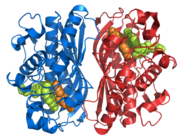From Proteopedia
proteopedia linkproteopedia link
| This Sandbox is Reserved from January 10, 2010, through April 10, 2011 for use in BCMB 307-Proteins course taught by Andrea Gorrell at the University of Northern British Columbia, Prince George, BC, Canada.
|
To get started:
- Click the edit this page tab at the top. Save the page after each step, then edit it again.
- Click the 3D button (when editing, above the wikitext box) to insert Jmol.
- show the Scene authoring tools, create a molecular scene, and save it. Copy the green link into the page.
- Add a description of your scene. Use the buttons above the wikitext box for bold, italics, links, headlines, etc.
More help: Help:Editing
|
Thymidylate Synthase
Thymidylate Synthase is a protein found in all organisms that make DNA. Thymidylate Synthase (TS) is the essential enzyme that catalyzes the formation of dTMP from dUMP, using 5,10-methylenetetrahydrofolate (mTHF) as a cosubstrate [1].
Overview
Thymidylate Synthase catalyzes the reductive methylation of deoxyuridylic acid during the de novo synthesis of thymidylic acid [2]. This reaction occurs primarily during the S phase of the cell cycle. Thymidylate synthase is an essential enzyme in proliferating cells that are not supplied with an alternate source of thymidine nucleotides [2]. Research has shown that thymidylate synthase enzyme levels are much higher in rapidly proliferating cells than in non dividing cells [2].

Figure 2:Thymidylate Synthase
Mammalian Thymidylate Synthase
Human and other mammalian thymidylate synthase enzyme have a N-terminal extension of aprox 27 amino acids [3]. This extension is not present in bacterial thymidylate synthase [3]. The extension is believed to play a primary role in protein turnover however not in catalytic activity [3].
Mechanism of Thymidylate Synthase Initiation
Thymidylate synthase converts dUMP to dTMP and is labeled as the rate-limiting enzyme in the synthesis of pyrimidine nucleotides, which are required for DNA synthesis [4]. The conversion of dUMP to dTMP is done with a cosubstrate mTHF [4]. The reaction is initiated by the active site cysteine, Cys195, is attacked by C6 of dUMP and this leads to the formation of C5 of dUMP [4]. The formation generates a second covalent bond between dUMP and mTHF and eventually a ternary catalytic complex [4]. The role of in the conversion of dUMP to dTMP can be important to proper structure and interactions that are required to initiate the formation of C5 dUMP.
Significance
References
- ↑ Huang, X., Gibson, L. M., Bell, B. J., Lovelace, L. L., Marjorette, M., Peña, O., et al. (2011). Replacement of Val3 in Human Thymidylate Synthase Affects its Kinetic Properties and Intracellular Stability. NIH Public Access, 49(11), 2475-2482. doi: 10.1021/bi901457e.Replacement.
- ↑ 2.0 2.1 2.2 Jenh, C. H., Rao, L. G., & Johnson, L. F. (1985). Regulation of thymidylate synthase enzyme synthesis in 5-fluorodeoxyuridine-resistant mouse fibroblasts during the transition from the resting to growing state. Journal of cellular physiology, 122(1), 149-54. doi: 10.1002/jcp.1041220122.
- ↑ 3.0 3.1 3.2 Huang, X., Gibson, L. M., Bell, B. J., Lovelace, L. L., Peña, M. M. O., Berger, F. G., et al. (2010). Replacement of Val3 in human thymidylate synthase affects its kinetic properties and intracellular stability . Biochemistry, 49(11), 2475-82. doi: 10.1021/bi901457e.
- ↑ 4.0 4.1 4.2 4.3 Yamada, H., Ichikawa, W., Uetake, H., Shirota, Y., Nihei, Z., Sugihara, K., et al. (2001). Thymidylate synthase gene expression in primary colorectal cancer and metastatic sites. Clinical colorectal cancer, 1(3), 169-73; discussion 174. Retrieved from http://www.ncbi.nlm.nih.gov/pubmed/12450430.


